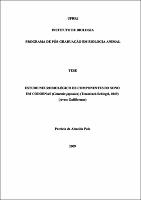| ???jsp.display-item.social.title??? |


|
Please use this identifier to cite or link to this item:
https://tede.ufrrj.br/jspui/handle/jspui/5595| ???metadata.dc.type???: | Tese |
| Title: | Estudo neurobiológico de componentes do sono em codornas (Coturnix japonica) (Temminck Schlegel, 1849) (Aves: Galliformes) |
| Other Titles: | Study of neurobiologic components of the sleep in quails (Coturnix japonica) (Temminck Schlegel, 1849) (Birds: Galliformes) |
| ???metadata.dc.creator???: | Polo, Patrícia de Almeida  |
| ???metadata.dc.contributor.advisor1???: | Reis, Luis Carlos |
| ???metadata.dc.contributor.referee1???: | Silva, Hélio Ricardo da |
| ???metadata.dc.contributor.referee2???: | Piratelli, Augusto João |
| ???metadata.dc.contributor.referee3???: | Ferreira, Ildemar |
| ???metadata.dc.contributor.referee4???: | Mendes, Lys Angela Favaroni |
| ???metadata.dc.contributor.referee5???: | Luis Carlos Reis |
| ???metadata.dc.description.resumo???: | Esse trabalho deu continuidade a um achado incidental do Laboratório de Fisiologia Animal da UFRRJ, no Departamento de Ciências Fisiológicas, no qual, codornas tratadas perifericamente com serotonina, em um estudo sobre comportamento alimentar, apresentaram comportamentos semelhantes ao sono. A partir dessa evidência, a idéia de que a serotonina permeia a barreira hematoencefálica de aves, diferentemente de mamíferos, incitou novas investigações neurofarmacológicas e comportamentais. Foi realizado, primeiramente, um estudo com antagonistas e agonistas de receptores serotoninérgicos, confirmando a permeabilidade da barreira hematoencefálica de codornas à essa amina biogênica e sua participação em mecanismos centrais envolvidos na regulação de comportamentos semelhantes aos do sono. Esse trabalho resultou em uma publicação na Brazilian Joumal of Biology, em 2007, intitulada "Behavioral and neuropharmacological evidence that serotonin crosses the blood-brain barrier in Coturnix japonica (Gallifonnes: Aves)". Levando-se em consideração que a serotonina é precursora da melatonina, e que esta última está envolvida no controle do ritmo circadiano, continuou-se a investigação, em tomo das alterações séricas de melatonina, mediante administração do precursor da serotonina, L-5-hidróxi-triptofano. Esse estudo resultou na publicação do segundo artigo na Brazilian Journal of Biology, em 2007, "Nocturnal plasma leveis of melatonin in quails (Coturnix japonica) injected with L-5-hydroxy-tryptophan". Uma vez que os comportamentos relacionados ao sono envolvem uma série de inibições centrais e que o ácido y-amino-butírico (GABA) é o maior neurotransmissor central do sistema nervoso central, continuou-se a explorar neurofarmacológica e comportamentalmente, o sono em codornas, abordando-se um tipo de receptor gabaérgico, o complexo receptor GABAA. O estudo resultou na última publicação desse doutoramento, Study of GABAA receptors on the sleep-lik:e behavior in Coturnix japonica (Temminck Schlegel, 1849) (Galliformes: Aves), na Joumal of Comparative Physiology A, em 2008. O objetivo dessa tese não foi traçar um paralelo filogenético entre aves e mamíferos, entretanto, muitas evidências foram inevitáveis. Certamente, esse trabalho contribuiu para ampliar o conhecimento científico sobre os elementos estudados. Ainda há muito o que se investigar a respeito do sono, não só em aves, como também em mamíferos. |
| Abstract: | This work gives continuity to an incidental discovery from the Laboratory of Animal Plhysiology of UFRRJ, in the Department of Physiologic Science in which quails were treated periphericaly by serotonin, in a study of feeding behavior became sleep. From this evidence, the idea of which serotonin permeates the blood-brain barrier (BBB) of the birds, differently to mammals, incited new investigations about neuropharmacology and regarding this issue. Firstly, a study of antagonists e agonists of serotonergic receptors was held, confirming the permeability of the barrier of (BBB) of quails to serotonin and your participation in the central mechanisms involved in the regulation of the similar sleep-like behaviors. This research resulted in a publication of a first in the Brazilian Journal of Biology, in 2007, entitled "Behavioral and neuropharmacological evidence that serotonin crosses the bloodbrain barrier in Cortunix japonica (Galliformes: Aves). Taking into consideration that the serotonin is the precursor of melatonin and this last one is involved in the control of the circadian rhythm, we continued with the investigation about the plasma leveis of melatonin, by means of application of the serotonin precursor, L-5-hydroxy-tryptophan. This study resulted in the publication of a second article in the Brazilian Journal of Biology, in 2007, "Nocturnal plasma levels of melatonin in quails (Cortunix japonica) injected with L-5-hydroxy-tryptophan". Once the behaviors related to sleep involves a series of central inhibition and the y-aminobutyric acid (GABA) is the biggest central inhibitory neurotransmitter of the central nervous system, we continued exploring behavioral and neuropharmacologically broaching the one type of gabaergic receptor, aiming the sleep of quails, the complex receptor GABAA. This work resulted in the third and last publication of this doctorate work, "Study of GABAA receptors on the sleep-like behavior in Cortunix japonica (Temminck Schlegel, 1849) (Galliformes: Aves)", in the Journal of Comparative Physiology A, in 2008. Toe aim of this thesis was not to draw a parallel between birds and mammals. However, many evidences were inevitable. Certainly, this research contributed to increase the scientific knowledge of the analysed elements. There is still too much to investigate concerning sleep, not only in birds, but also in mammals. |
| Keywords: | Sono codornas comportamento Sleep quails behavior |
| ???metadata.dc.subject.cnpq???: | Fisiologia |
| Language: | por |
| ???metadata.dc.publisher.country???: | Brasil |
| Publisher: | Universidade Federal Rural do Rio de Janeiro |
| ???metadata.dc.publisher.initials???: | UFRRJ |
| ???metadata.dc.publisher.department???: | Instituto de Ciências Biológicas e da Saúde |
| ???metadata.dc.publisher.program???: | Programa de Pós-Graduação em Biologia Animal |
| Citation: | POLO, Patrícia de Almeida. Estudo neurobiológico de componentes do sono em codornas (Coturnix japonica) (Temminck Schlegel, 1849) (Aves: Galliformes). 2009. 78 f. Tese (Doutorado em Biologia Animal) - Instituto de Ciências Biológicas e da Saúde, Universidade Federal Rural do Rio de Janeiro, Seropédica, RJ, 2009. |
| ???metadata.dc.rights???: | Acesso Aberto |
| URI: | https://tede.ufrrj.br/jspui/handle/jspui/5595 |
| Issue Date: | 6-Mar-2009 |
| Appears in Collections: | Doutorado em Biologia Animal |
Files in This Item:
| File | Description | Size | Format | |
|---|---|---|---|---|
| 2009 - Patricia de Almeida Polo.pdf | 1.01 MB | Adobe PDF |  Download/Open Preview |
Items in DSpace are protected by copyright, with all rights reserved, unless otherwise indicated.




